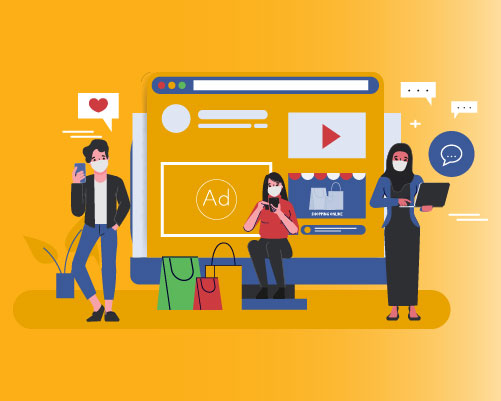Media buying is a strategic process in advertising and marketing that involves acquiring media space or time from various media platforms to display or broadcast advertisements. It is a crucial aspect of a company’s overall marketing strategy, helping to reach a target audience effectively and maximize the impact of advertising campaigns.
Media buying involves identifying the most suitable media channels, negotiating rates and terms, and placing advertisements to achieve the desired reach and frequency. The goal is to optimize the allocation of advertising budgets and ensure that messages are delivered to the right audience at the right time.
Media buyers typically work closely with advertising agencies or directly with clients to understand their advertising objectives, target audience demographics, and budget constraints. They conduct market research and analysis to determine which media channels, such as television, radio, print, outdoor billboards, websites, or social media platforms, would be most effective in reaching the desired audience.
Once the media channels are selected, media buyers negotiate pricing and placement terms with media outlets, aiming to secure the best possible rates and optimal ad placements. They may also consider factors like audience demographics, geographic targeting, and specific time slots or publication dates to maximize the impact of the advertisements.
Media buying also involves monitoring and tracking the performance of advertisements. This includes analyzing data and metrics to evaluate the effectiveness of media placements, such as reach, frequency, audience engagement, and conversion rates. Based on the insights gathered, media buyers can make adjustments to optimize future media buying decisions and improve the return on investment (ROI) for advertising campaigns.
In summary, media buying is the strategic process of acquiring media space or time from various outlets to place advertisements in order to reach a target audience effectively and achieve marketing objectives.
Table of Contents
What is media buying?
Media buying is the process of acquiring advertising space or time across various media channels to reach a target audience effectively. It is a strategic activity performed by advertisers, advertising agencies, or media buying agencies to plan, negotiate, and purchase ad placements on behalf of their clients. The goal of media buying is to maximize the reach and impact of advertising campaigns while optimizing the allocation of advertising budgets.
Media buying encompasses several steps, including

- Define objectives: The first step is to clearly identify the advertising goals and objectives. This could include increasing brand awareness, driving website traffic, generating leads, or promoting a specific product or service.
- Identify target audience: A crucial aspect of media buying is understanding the target audience. It involves gathering data and insights about the demographic, geographic, psychographic, and behavioral characteristics of the desired audience.
- Media planning: Media planners determine which media channels are most suitable for reaching the target audience. This includes evaluating traditional media channels such as television, radio, newspapers, magazines, and outdoor billboards, as well as digital platforms like websites, social media, mobile apps, and streaming services.
- Media research: Media buyers conduct research to gather information about the available media options, such as audience reach, demographics, pricing, and ad placement opportunities. They may analyze ratings, circulation numbers, audience demographics, and other relevant data to make informed decisions.
- Budget allocation: Based on the objectives and target audience, media buyers allocate the advertising budget across different media channels. They consider factors such as the cost per thousand impressions (CPM), cost per click (CPC), or cost per acquisition (CPA) to determine the most effective allocation strategy.
- Negotiation and buying: Media buyers negotiate with media representatives to secure the best rates and ad placements. They aim to maximize the value of the advertising budget and ensure that the ads are positioned in optimal locations or time slots for maximum visibility and audience engagement.
- Campaign implementation: Once the media buys are finalized, the media buying team coordinates with creative teams to deliver the advertising assets required for each media channel. This includes designing and producing advertisements in various formats and sizes to meet the specifications of each platform.
- Monitoring and optimization: Throughout the campaign, media buyers continuously monitor the performance of the ads and make adjustments as needed. They track key metrics such as impressions, clicks, conversions, and return on investment (ROI) to evaluate the effectiveness of the media buys. Optimization may involve adjusting targeting parameters, creative elements, or media placements to improve campaign performance.
What Do Media Buyers Do?

Media buyers play a crucial role in the advertising industry. Their primary responsibility is to plan, negotiate, and purchase advertising space or time across various media channels on behalf of advertisers.
Here are the key tasks and responsibilities of media buyers:
- Research and Analysis: Media buyers conduct extensive research and analysis to understand the target audience, market trends, and media landscape. They gather data on audience demographics, reach, and engagement levels across different media channels. This information helps them make informed decisions about where to place ads to reach the desired audience effectively.
- Media Planning: Based on the research and analysis, media buyers develop strategic media plans. They determine the optimal mix of media channels, such as television, radio, print, digital, or outdoor, to achieve the campaign objectives. Media buyers select specific media outlets, programs, publications, or websites that align with the target audience and campaign goals.
- Budget Allocation: Media buyers work closely with advertisers to determine the advertising budget for each campaign. They allocate the budget across different media channels and negotiate rates with media vendors to maximize the value of the budget. Media buyers strive to achieve the best possible media placements at the most cost-effective prices.
- Negotiation and Buying: Media buyers negotiate with media vendors, such as TV networks, radio stations, publishers, or digital platforms, to secure advertising space or time. They aim to obtain favorable rates, added value, or special placement opportunities for their clients. Negotiation skills, market knowledge, and industry relationships are crucial in achieving cost-effective media buying.
- Campaign Execution: Once the media buys are finalized, media buyers oversee the implementation and execution of the advertising campaigns. They ensure that the ads are scheduled correctly, monitor delivery, and manage any changes or adjustments needed during the campaign period. Media buyers collaborate with creative teams, production houses, and media vendors to ensure smooth campaign execution.
- Performance Analysis: Media buyers monitor the performance of the advertising campaigns by tracking key metrics and analyzing data. They assess the effectiveness and ROI of each media channel and placement to evaluate campaign success. Based on the performance analysis, media buyers make recommendations for adjustments or optimizations to maximize the impact of future campaigns.
- Industry Knowledge and Trends: Media buyers stay up-to-date with industry trends, emerging technologies, and changes in consumer behavior. They continuously research new media channels, ad formats, and targeting options to ensure their clients’ campaigns stay relevant and effective in reaching the target audience.
In summary, media buyers are responsible for strategic media planning, budget allocation, negotiation, and execution of advertising campaigns across various media channels. Their expertise and knowledge of the media landscape are crucial in achieving cost-effective and impactful media buying on behalf of their clients.
The target audience in Media Buying: Researching demographics and psychographics

Understanding the audience is a crucial part of media buying to ensure that the right media channels and messaging are used to reach the target market effectively. This involves researching and analyzing both demographics and psychographics of the intended audience.
Let’s explore these concepts further:
- Demographics: Demographic information provides insights into the measurable characteristics of a target audience. It includes factors such as age, gender, income, education level, occupation, geographic location, and ethnic background. Demographic data helps media buyers identify the segments of the population that are most likely to be interested in a product or service.
By studying demographics, media buyers can determine which media channels are popular among specific age groups or geographic regions. For example, if the target audience is primarily young adults, digital platforms like social media or streaming services might be more effective, whereas if the target audience is older adults, traditional media such as television or print media might be more suitable.
- Psychographics: Psychographics go beyond demographic characteristics and delve into the psychological and behavioral attributes of the audience. It focuses on understanding their interests, attitudes, values, lifestyle choices, motivations, and purchasing behaviors. Psychographic data helps media buyers create more targeted and personalized messages that resonate with the audience on a deeper level.
Psychographic research can be conducted through surveys, focus groups, or data analysis from various sources. It helps media buyers identify the audience’s preferences, hobbies, aspirations, opinions, and the media platforms they engage with. For example, if the target audience is environmentally conscious, media buyers might prioritize eco-friendly publications or digital platforms that align with those values.
By combining demographic and psychographic data, media buyers can create detailed audience profiles or buyer personas. These profiles provide a holistic understanding of the target market and enable media buyers to make informed decisions about media channel selection, ad placement, messaging, and overall media strategy.
Additionally, media buyers can leverage third-party data providers or media research companies that offer audience insights and analytics tools. These resources can provide valuable information about audience behavior, media consumption habits, and purchasing patterns, helping media buyers refine their targeting strategies further.
Overall, researching demographics and psychographics allows media buyers to gain a deeper understanding of their target audience, enabling them to make data-driven decisions in selecting the right media channels, optimizing ad placements, and tailoring messages to resonate with the intended audience.
Types of Media Buying Platforms
Choosing the right platform for Media Buying: TV, radio, print, digital, or outdoor
Choosing the right platform in media buying depends on various factors, including the target audience, campaign objectives, budget, and the nature of the product or service being advertised. Here’s an overview of different platforms commonly used in media buying:
TV (Television) Media Buying
TV advertising remains a popular choice for reaching a wide audience, particularly for mass-market products or services. It offers the advantage of audio-visual storytelling and the potential for high reach. TV can be effective for building brand awareness and delivering impactful messages. However, it can also be costly, especially during prime time or popular shows.
TV Media Buying Cost
TV media buying costs can vary significantly depending on several factors, including the following:
- Network and Channel: The choice of network or channel on which you advertise will impact the cost. Prime-time slots on popular networks often command higher prices due to their wider reach and higher viewership. Local or regional channels may offer more affordable options.
- Program and Time of Day: The specific program and time slot during which your ad airs will influence the cost. Highly rated shows or specific time slots with larger audiences may have higher advertising rates. Primetime slots, such as evening hours when viewership is typically higher, may be more expensive compared to daytime or late-night slots.
- Duration and Frequency: The length of your TV campaign and the frequency at which your ad is aired will affect the overall cost. Longer campaigns or those with higher frequency (more airings) will generally require a larger budget.
- Geographic Coverage: The geographic scope of your TV campaign can impact the cost. Advertising in larger markets or across multiple regions will generally be more expensive compared to local or regional campaigns.
- Production Costs: In addition to media buying costs, you’ll need to consider production costs for creating your TV commercial. This includes costs associated with scripting, filming, editing, graphics, and voiceover talent. Production costs can vary depending on the complexity and quality of the ad.
- Negotiation and Buying Power: Effective negotiation skills and buying power can influence the cost of TV media buying. Agencies or advertisers with significant buying power or the ability to negotiate favorable rates may achieve more cost-efficient campaigns.
It’s important to note that TV media buying costs can be significant, especially for prime-time slots on popular networks. It’s recommended to work with media buying professionals or agencies who have experience in TV advertising. They can provide guidance, negotiate on your behalf, and help you develop a media plan that aligns with your budget and objectives.
Additionally, it’s crucial to consider the effectiveness and reach of TV advertising in relation to your target audience and campaign goals. Evaluating the cost-effectiveness of TV media buying should also include assessing the potential impact and ROI that can be achieved through TV advertising compared to other channels or digital media options.
Radio Media Buying
Radio advertising is a more affordable option that can be effective for reaching a local or regional audience. It allows for audio-based storytelling and can be used to target specific demographics or interest groups. Radio is often used for promoting local businesses, events, or specific offers. It has the advantage of being mobile-friendly and can reach listeners during commuting or specific time slots.
Radio Media Buying Cost
The cost of radio media buying can vary based on several factors.
Here are some key factors that can influence the cost of radio advertising:
- Market Size: The size of the radio market or geographic area where you want to advertise plays a significant role in determining the cost. Larger markets, such as major cities or regions with high population density, often have higher advertising rates compared to smaller or less populated areas.
- Time of Day and Day of the Week: Radio stations typically have different pricing tiers based on the time of day and day of the week. Prime-time slots, such as morning drive time (6 am to 10 am) and afternoon drive time (3 pm to 7 pm), are generally more expensive due to higher listener numbers. Rates may also vary between weekdays and weekends.
- Audience Size and Demographics: The size and demographics of the radio station’s audience can impact the cost. Stations with larger audience reach, especially those targeting a specific demographic that aligns with your target audience, generally have higher rates. The more targeted and valuable the audience, the higher the cost.
- Ad Length and Frequency: The length and frequency of your radio ads can affect the cost. Longer ad spots, such as 60-second spots, are usually more expensive than 30-second or 15-second spots. Running your ads more frequently throughout the day or week will increase the overall cost.
- Competition and Demand: The level of competition among advertisers for airtime on a particular radio station can impact pricing. If there is high demand for ad spots during specific times or on popular stations, prices may increase due to increased competition for limited inventory.
- Negotiation Skills: The negotiation skills of the media buyer or agency can influence the final cost of radio media buying. Skilled negotiators may be able to secure better rates, added value, or discounts from the radio station, resulting in cost savings for the advertiser.
- Additional Services: Additional services such as creative development, production, or ad customization may incur additional costs. If you require assistance in creating the radio ad or need specific customization for your campaign, these services may be provided by the radio station or external vendors at an additional cost.
It’s important to note that radio media buying costs can vary significantly depending on the specific market, station, time slots, and other factors mentioned above. It’s recommended to work closely with media buying professionals or agencies with expertise in radio advertising to navigate these factors and optimize your budget for the best results.
Print Media Buying
Print media includes newspapers, magazines, and other physical publications. Print advertising can still be relevant for specific target markets, such as niche audiences or older demographics. It offers a tangible and longer-lasting format, allowing for detailed information and visual design. However, print has faced challenges due to the rise of digital media, and its reach and effectiveness may vary depending on the publication and readership.
Print media buying cost
The cost of print media buying can vary depending on several factors, including the following:
- Publication and Circulation: The choice of publication plays a significant role in determining the cost. Popular and widely circulated newspapers or magazines generally have higher advertising rates due to their larger reach and readership. Niche or specialized publications may offer more affordable options.
- Ad Size and Placement: The size and placement of your ad within the publication will impact the cost. Full-page ads or prime positions like the front cover or back page tend to be more expensive compared to smaller ads or placements within the inner pages. Different ad sizes and formats, such as half-page, quarter-page, or classified ads, will also have varying price ranges.
- Frequency and Duration: The frequency and duration of your print advertising campaign will affect the overall cost. Longer campaigns or those with higher frequency (more insertions) will generally require a larger budget. Publishers often offer discounts for bulk or long-term commitments.
- Geographic Coverage: The geographic scope of your print campaign can impact the cost. Advertising in national or regional publications will generally be more expensive compared to local or community newspapers or magazines.
- Production Costs: In addition to media buying costs, you’ll need to consider production costs for designing and printing your ad. This includes graphic design, artwork, and any additional fees for professional assistance. Production costs can vary based on the complexity and quality of the ad.
- Negotiation and Buying Power: Effective negotiation skills and buying power can influence the cost of print media buying. Agencies or advertisers with significant buying power or the ability to negotiate favorable rates may achieve more cost-efficient campaigns.
It’s important to note that print media buying costs can vary widely based on the factors mentioned above. It’s recommended to work with media buying professionals or agencies who have experience in print advertising. They can provide guidance, negotiate on your behalf, and help you develop a media plan that aligns with your budget and objectives.
Additionally, it’s crucial to consider the effectiveness and reach of print advertising in relation to your target audience and campaign goals. Print media buying should be evaluated in terms of its potential impact and ROI compared to other advertising channels or digital media options.
Digital Media Buying
Digital media encompasses various platforms such as websites, social media, search engines, mobile apps, and streaming services. Digital advertising provides targeted reach, precise audience targeting options, and the ability to track and measure campaign performance. It offers a wide range of ad formats, including display ads, video ads, native ads, and sponsored content. Digital media allows for real-time optimization, flexibility, and the ability to reach global audiences. It is particularly effective for reaching younger audiences and those who are highly connected online.
Digital Media Buying Platforms
Digital platforms have become an integral part of media buying due to their wide reach, targeting capabilities, and measurable results.
Here are some key digital platforms commonly used in media buying:
- Websites:
Advertising on websites allows you to display banner ads or sponsored content on relevant webpages. You can leverage popular websites or niche publications that attract your target audience. Display advertising networks and programmatic buying platforms make it easier to reach specific demographics or target users based on their browsing behavior or interests. Know more about our website development services and website cost.
- Social Media:
Social media platforms like Facebook, Instagram, Twitter, LinkedIn, and YouTube offer powerful advertising options. They provide sophisticated targeting capabilities based on user demographics, interests, behaviors, and even specific criteria such as job titles or company affiliations. Social media advertising services allow for various ad formats, including images, videos, carousel ads, and sponsored posts, helping to engage and drive user actions. Know more about our social media management services.
- Search Engines:
Search engine advertising, often referred to as search engine marketing (SEM) or pay-per-click PPC advertising, allows you to display ads on search engine result pages. Google Ads is the dominant platform in this space, with Bing Ads being another notable option. With search engine advertising, you can bid on keywords relevant to your business, and your ads will appear when users search for those keywords. This allows for highly targeted advertising and capturing user intent at the moment of search. Know how to advertise on google ads and google ads benefits.
- Mobile Advertising:
As mobile usage continues to grow, mobile advertising presents significant opportunities. This includes in-app advertising, mobile display ads, and mobile video ads. Mobile ads can be targeted based on user location, app usage patterns, device type, and other factors. Mobile advertising platforms and networks enable advertisers to reach users while they are using mobile apps or browsing the mobile web.
- Video Streaming and OTT:
Streaming platforms like YouTube, Hulu, Amazon Prime Video, and others offer opportunities for video advertising. Video ads can be displayed before, during, or after video content, or within streaming services (Over-the-Top or OTT advertising). These platforms provide precise targeting options and extensive reach, allowing for engaging storytelling and brand exposure.
- Native Advertising:
Native advertising involves integrating ads seamlessly into the platform’s content, matching its look and feel. This can be in the form of sponsored articles, recommended content widgets, or in-feed ads. Native ads blend in with the user experience, resulting in higher engagement and better user acceptance.
- Programmatic Advertising:
Programmatic advertising uses automated technology and algorithms to buy and optimize digital ad inventory. It involves real-time bidding (RTB) and allows for precise audience targeting and data-driven optimization. Programmatic buying platforms provide access to a vast network of websites and ad exchanges, making it efficient and scalable for media buying.
When using digital platforms in media buying, it’s essential to define campaign objectives, target audience, and key performance indicators (KPIs) to ensure effective targeting, tracking, and measurement. Regular monitoring and analysis of campaign performance enable media buyers to make data-driven decisions, optimize budgets, and maximize the return on investment (ROI) for digital advertising efforts.
Also Read: Digital Marketing Cost
Digital Media Buying Cost
The cost of digital media buying can vary based on several factors, including the specific digital platforms, targeting options, ad formats, and the size and competitiveness of the target audience.
Here are some key considerations regarding the cost of digital media buying:
- Ad Format and Placement: The choice of ad format and placement within digital platforms can impact the cost. For example, display ads, video ads, native ads, and sponsored content may have different pricing structures. Premium placements or highly visible positions within websites or social media feeds might command higher prices compared to standard placements.
- Bidding Model: In programmatic advertising, the bidding model plays a significant role in determining costs. Real-time bidding (RTB) involves bidding for ad impressions in real time, and the cost will depend on factors such as competition, targeting criteria, and the quality of the ad inventory. Different bidding strategies, such as cost per thousand impressions (CPM) or cost per click (CPC), can affect the overall cost.
- Targeting Options: Advanced targeting options within digital platforms allow advertisers to narrow down their audience based on demographics, interests, behaviors, and other parameters. However, more precise targeting options may come with additional costs. Some targeting options, such as remarketing or custom audience targeting, may require a minimum budget threshold.
- Platform and Audience Size: The popularity and reach of digital platforms can impact the cost. Platforms with larger user bases and higher engagement rates often have higher advertising costs due to increased demand. For example, advertising on popular social media platforms like Facebook or Instagram may be more expensive compared to smaller, niche websites or apps.
- Geographic Location: The location and targeting scope of your campaign can influence the cost. Advertising in highly populated areas or specific geographic regions with high competition may require a larger budget. Targeting broad regions or countries compared to specific cities or zip codes may also affect costs.
- Ad Duration and Frequency: The duration and frequency of your digital advertising campaign will impact the overall cost. Longer campaigns or those with higher frequency (more ad impressions) will generally require a larger budget. However, digital advertising often offers flexibility in terms of budget allocation and allows advertisers to adjust spending based on campaign performance.
- Campaign Objectives: The specific goals and objectives of your campaign can influence the cost. For instance, if your campaign aims for higher visibility, brand awareness, or engagement, it may require a larger budget compared to a campaign focused on driving conversions or specific actions.
It’s important to work closely with digital media buying professionals or digital marketing agencies who can provide insights into the cost factors specific to your campaign. They can help develop a comprehensive media plan and provide cost estimates based on your target audience, ad formats, platforms, and campaign goals, allowing you to allocate your budget effectively and maximize the return on investment (ROI) for your digital media buying efforts. Know how much does digital marketing cost.
Outdoor Media Buying
Outdoor advertising includes billboards, transit ads, posters, and signage. It offers wide visibility and exposure, particularly in high-traffic areas. Outdoor ads can be effective for generating brand awareness and capturing attention. They are often used for local promotions, events, or to complement other media channels. However, outdoor advertising may have limited targeting options compared to other platforms, and its impact can vary depending on the location and design of the ads.
Outdoor Media Buying Cost
Outdoor media buying costs can vary depending on several factors related to the specific outdoor advertising format and location.
Here are some key considerations:
- Billboard Size and Location: The size and location of the billboard play a significant role in determining the cost. Larger billboards or those located in high-traffic areas, such as busy highways or popular urban centers, generally command higher prices due to their increased visibility.
- Duration and Availability: The duration of your outdoor advertising campaign and the availability of the desired billboard location will impact the cost. Longer campaigns or those during peak seasons may have higher rates. Availability of prime billboard locations in high-demand areas can also affect the cost.
- Geographic Coverage: The geographic coverage of your outdoor campaign will influence the cost. Advertising in major cities or densely populated areas may be more expensive compared to smaller towns or rural regions. Rates can also vary depending on the market and competition in the specific area.
- Special Features and Enhancements: Some outdoor advertising options offer special features or enhancements, such as digital billboards, interactive elements, or lighting effects. These additional features may come with an extra cost.
- Production Costs: In addition to media buying costs, you’ll need to consider production costs for designing and printing the billboard artwork. This includes graphic design, artwork, printing, and installation. Production costs can vary based on the complexity, size, and material of the billboard.
- Negotiation and Buying Power: Effective negotiation skills and buying power can influence the cost of outdoor media buying. Agencies or advertisers with significant buying power or the ability to negotiate favorable rates may achieve more cost-efficient campaigns.
It’s important to note that outdoor media buying costs can vary significantly based on the factors mentioned above. Working with media buying professionals or agencies experienced in outdoor advertising can help you navigate the landscape, negotiate rates, and develop a media plan that aligns with your budget and objectives.
Additionally, it’s crucial to consider the effectiveness and reach of outdoor advertising in relation to your target audience and campaign goals. Evaluating the cost-effectiveness of outdoor media buying should include assessing the potential impact and ROI that can be achieved through outdoor advertising compared to other advertising channels or digital media options.
When choosing the right platform for media buying, it’s essential to consider the target audience’s media consumption habits, campaign goals, available budget, and the specific strengths and limitations of each platform. Often, a multi-channel approach combining different platforms can be effective in reaching a diverse audience and maximizing campaign impact. Media buyers should also monitor and analyze the performance of each platform to make data-driven decisions and optimize future media buying strategies.
Negotiating rates and placements: Getting the best deal for your budget in Media Buying

Negotiating rates and placements is a critical aspect of media buying to ensure you get the best possible deal for your budget.
Here are some strategies to help you negotiate effectively:
- Research and Compare:
Before entering negotiations, conduct thorough research to understand the market rates for different media channels and placements. Gather data on pricing, ad formats, audience reach, and competitor activities. This information will empower you during negotiations and help you assess whether the proposed rates are fair.
- Set Clear Objectives:
Define your campaign objectives and desired outcomes before entering negotiations. Clarify the target audience, reach, frequency, and key performance indicators (KPIs) you aim to achieve. Having clear objectives will guide your negotiation strategy and ensure that the media partner understands your goals.
- Leverage Competition:
Create competition among media outlets by reaching out to multiple platforms or publications. Presenting multiple options to potential partners can incentivize them to provide better rates or additional value-added services to secure your business. Be transparent about your intentions to explore other opportunities, as this can enhance your bargaining position.
- Demonstrate Value:
Highlight the value that your campaign can bring to the media outlet. Showcase your target audience’s relevance to their platform and how your advertising can drive engagement or increase their reach. Present case studies or success stories from previous campaigns to demonstrate the potential impact and return on investment (ROI).
- Bundle or Commitment Deals:
Consider bundling multiple placements or offering a long-term commitment to negotiate better rates. Media outlets may be more inclined to offer discounts or incentives if they know they will have a consistent advertising partner over an extended period. Negotiate volume discounts or explore package deals that include multiple media channels.
- Seek Added Value:
In addition to negotiating rates, explore opportunities for added value or extra benefits. This could include bonus impressions, priority placements, preferred positioning, exclusivity, or additional promotional activities. Look for win-win situations where both parties can benefit.
- Flexibility and Trade-Offs:
Be open to finding compromises and trade-offs during negotiations. Consider alternative ad formats, time slots, or placements that may provide cost advantages without compromising your campaign objectives. Flexibility can lead to more favorable agreements and better utilization of your budget.
- Build Relationships:
Establishing and nurturing relationships with media representatives can be beneficial in the long run. Engage in open communication, maintain professionalism, and express interest in building a long-term partnership. Building trust and rapport may result in more favorable negotiations and ongoing collaboration.
- Track and Evaluate:
After reaching an agreement, continuously monitor and evaluate the performance of your media placements. Assess whether the negotiated rates and placements are delivering the desired results and adjust your strategy if necessary. Data-driven insights will help inform future negotiations and optimize your media buying efforts.
Remember, successful negotiation in media buying requires preparation, clear objectives, flexibility, and the ability to build mutually beneficial relationships. By employing these strategies, you can maximize the value of your media buying budget and achieve your advertising goals.
Also Check: Website Development Cost in India
Measuring Success in Media Buying: Analytics and Metrics to Track ROI

Measuring success in media buying involves tracking key analytics and metrics to evaluate the return on investment (ROI) and assess the effectiveness of your advertising campaigns.
Here are some important analytics and metrics to consider:
- Impressions:
Impressions indicate the number of times your ad was displayed or seen by users. Tracking impressions helps measure the reach and visibility of your campaign. It provides insights into the potential audience exposure to your message.
- Clicks and Click-through Rate (CTR):
Clicks represent the number of times users clicked on your ad to visit your website or landing page. CTR is calculated by dividing the number of clicks by the number of impressions. It measures the engagement level and effectiveness of your ad in generating interest and driving traffic.
- Conversions:
Conversions measure the desired actions taken by users after interacting with your ad, such as making a purchase, filling out a form, subscribing to a newsletter, or downloading an app. Tracking conversions helps assess the direct impact of your campaign on achieving specific goals and objectives.
- Cost per Acquisition (CPA) or Cost per Conversion (CPC):
CPA or CPC represents the cost incurred for acquiring a customer or achieving a conversion. It is calculated by dividing the total cost of the campaign by the number of acquisitions or conversions. Monitoring CPA or CPC allows you to evaluate the cost-effectiveness of your media buying efforts and optimize budget allocation.
- Return on Ad Spend (ROAS):
ROAS measures the revenue generated in relation to the amount spent on advertising. It is calculated by dividing the total revenue by the total ad spend. ROAS helps determine the profitability of your campaigns and allows you to allocate resources to the most effective media channels or placements.
- Engagement Metrics:
Engagement metrics evaluate user interaction and involvement with your ad, such as likes, shares, comments, and video views. These metrics provide insights into the level of audience engagement and the resonance of your message.
- Viewability:
Viewability measures the percentage of ad impressions that are viewable by users. It ensures that your ads have a chance to be seen and evaluated accurately. Viewability metrics help assess the quality of ad placements and ensure that your media budget is effectively utilized.
- Return on Investment (ROI):
ROI measures the overall profitability of your media buying efforts. It takes into account the revenue generated compared to the total cost of advertising, including media spend and production costs. ROI provides a comprehensive assessment of the financial impact of your campaigns and helps guide future investment decisions.
- A/B Testing:
A/B testing involves comparing the performance of different ad creatives, placements, or targeting strategies. By running controlled experiments, you can determine which variations yield better results and optimize your media buying based on data-driven insights.
- Attribution Models:
Attribution models help determine how credit for conversions is assigned to different touchpoints along the customer journey. By understanding the impact of various media channels and interactions, you can allocate credit and optimize your media mix accordingly.
It’s important to establish clear goals and align your analytics and metrics with those goals. Regularly monitor, analyze, and interpret the data to gain insights into the performance of your media buying campaigns. Use these insights to refine your strategies, optimize your budget allocation, and improve the overall effectiveness and ROI of your media buying efforts.
Staying up-to-date with trends: Adapting to new technology and consumer behaviour in Media Buying

Staying up-to-date with trends and adapting to new technology and consumer behavior is crucial in media buying to ensure the effectiveness and relevance of your campaigns.
Here are some strategies to help you stay current and adaptable:
- Continuous Learning:
Make a commitment to ongoing learning and professional development. Stay updated on industry news, trends, and emerging technologies through industry publications, blogs, webinars, conferences, and networking events. Engage with industry experts, thought leaders, and fellow media buyers to exchange insights and learn from their experiences.
- Data and Analytics:
Leverage data and analytics to gain insights into consumer behavior, preferences, and media consumption habits. Regularly analyze and interpret the data from your campaigns to identify patterns, trends, and opportunities. Use data-driven insights to inform your media buying strategies and optimize your campaigns for better results.
- Embrace Digital Transformation:
Embrace the digital transformation in media buying and adapt to the evolving landscape. Explore new digital platforms, ad formats, and targeting options that align with changing consumer behaviors. Be open to experimenting with emerging technologies such as artificial intelligence (AI), machine learning (ML), programmatic advertising, and data-driven audience segmentation.
- Mobile and Cross-Channel Optimization:
Recognize the increasing importance of mobile devices and the rise of cross-channel consumer journeys. Optimize your campaigns for mobile platforms, ensuring that your ads are mobile-friendly, responsive, and designed for smaller screens. Embrace cross-channel strategies to reach consumers across multiple touchpoints, integrating your messaging and creating a cohesive brand experience.
- Social Media and Influencer Marketing:
Stay attuned to the influence of social media platforms and the power of influencer marketing. Understand how different social media channels are evolving, which ones are gaining popularity among your target audience, and how users are engaging with branded content. Explore partnerships with relevant influencers who can amplify your message and connect with their followers.
- Personalization and Customization:
Consumer expectations are shifting towards personalized and customized experiences. Invest in audience segmentation, dynamic ad creative, and tailored messaging to deliver more relevant and personalized campaigns. Leverage data and technology to target specific segments with messages that resonate with their interests, preferences, and needs.
- User-generated Content and Authenticity:
Recognize the value of user-generated content (UGC) and the importance of authenticity in consumer engagement. Encourage users to create and share content related to your brand or products, and leverage UGC in your campaigns. Authenticity and transparency are key in building trust and connecting with today’s consumers.
- Agile Campaign Management:
Adopt agile campaign management methodologies that allow for quick adaptation and optimization based on real-time data. Test and iterate your campaigns, monitor performance closely, and make adjustments as needed. Embrace a mindset of continuous improvement and flexibility to respond to changing consumer behaviors and market dynamics.
- Collaboration and Partnerships:
Collaborate with industry partners, media representatives, technology providers, and data partners to gain insights, access new opportunities, and stay informed about the latest trends and technologies. Foster relationships that enable knowledge sharing, cross-learning, and strategic collaborations that can benefit your media buying efforts.
- Monitor Competitive Landscape:
Keep a close eye on your competitors’ advertising strategies and media buying activities. Analyze their campaigns, messaging, and channel selection to identify opportunities or gaps in the market. Learn from their successes and failures to refine your own approach.
By embracing a proactive and adaptable mindset, staying informed about industry trends, and leveraging technology and data-driven insights, you can effectively adapt to changing consumer behaviors, adopt new technologies, and optimize your media buying strategies for better results and impact.
How much does media buying cost?
The cost of media buying can vary significantly depending on various factors such as the type of media channels, the size of the target audience, the duration and frequency of the campaign, the geographic location, and the level of competition in the market.
Here are some factors that can influence the cost:
- Media Channel: Different media channels have varying price ranges. Television, radio, and print media tend to be more expensive, while digital platforms often offer a wider range of budget options. The cost of advertising on specific platforms within each channel will also vary. For example, prime-time television slots or popular websites may command higher prices.
- Reach and Target Audience: The size and demographics of the target audience can impact the cost. Advertising to a broad audience with a wide reach will generally cost more compared to targeting a niche audience. Targeting specific demographics or using advanced targeting options within digital platforms may come with additional costs.
- Campaign Duration and Frequency: The length and frequency of the campaign will affect the overall cost. Longer campaigns or those with higher frequency (more ad placements) will typically require a larger budget. Short-term campaigns or limited-duration promotions may offer more cost-effective options.
- Market Competition: The level of competition in the market can influence the cost of media buying. In highly competitive markets or during peak advertising seasons, prices may increase due to increased demand for ad space or airtime.
- Negotiation and Buying Power: Effective negotiation skills, strategic partnerships, and buying power can influence the cost of media buying. Agencies or advertisers with significant buying power or the ability to negotiate favorable rates and added value may achieve more cost-efficient campaigns.
It’s important to note that media buying costs can vary widely, and there is no fixed price for media buying services. Media buying agencies or professionals often work with budgets provided by advertisers and strive to optimize the allocation of those budgets to achieve the best possible results within the given parameters.
To determine the specific cost of media buying for your campaign, it’s recommended to consult with media buying professionals or agencies who can provide insights tailored to your specific goals, target audience, and desired media channels. They can provide detailed cost estimates based on your requirements and help develop a media plan that fits your budget while maximizing the impact of your advertising efforts.
Factors That Affect Media Buying Cost
Several factors can influence the cost of media buying. Understanding these factors will help you better manage and estimate your media buying expenses.
Here are some key factors that can affect media buying costs:
- Media Channel: Different media channels have varying costs associated with them. Television, radio, print, digital, and outdoor advertising each have their own pricing structures. Television advertising, for example, tends to be more expensive than radio or print due to its broader reach and higher production costs.
- Ad Placement and Format: The placement of your ads within a media channel can impact the cost. Prime-time slots during popular TV shows or prominent ad placements in digital platforms often come with a higher price tag. Additionally, the format of the ad, such as the size of a print ad or the length of a TV or radio spot, can affect the cost.
- Audience Size and Demographics: The size and demographics of the target audience play a role in media buying costs. Media outlets with a larger audience typically charge higher rates due to the wider reach. Similarly, if you’re targeting a niche or specific demographic, the media channel that caters to that audience may charge higher prices.
- Competition and Demand: The level of competition for advertising space or airtime can influence the cost. If there is high demand for a particular media channel or during a specific period, such as the holiday season, prices may increase. Advertisers vying for limited inventory can drive up costs through bidding or increased competition.
- Seasonality and Timing: Media buying costs can fluctuate based on seasonality and timing. For instance, rates may be higher during peak seasons or holidays when there is increased consumer spending and higher demand for advertising. Planning your campaigns strategically, considering off-peak periods, can help manage costs.
- Negotiation Skills: The negotiation skills of the media buyer can impact the final cost. Experienced media buyers or agencies with established relationships with media vendors can often negotiate better rates, added value, or discounts, resulting in cost savings for the advertiser.
- Ad Campaign Duration and Frequency: The duration and frequency of your ad campaign can impact the overall cost. Longer campaigns or campaigns with higher frequency (more airtime or impressions) typically involve higher costs. Consider the optimal balance between reach and frequency to maximize the impact within your budget.
- Additional Services and Production Costs: Additional services required for your campaign, such as creative development, production, or ad optimization, can contribute to the overall media buying cost. These costs may vary depending on the complexity of the campaign and the level of customization required.
It’s important to note that these factors interact with each other, and the specific circumstances of your campaign will determine the overall media buying cost. Working closely with media buying professionals or agencies can help navigate these factors and optimize your budget to achieve the best possible results within your desired investment.
How to control the media buying cost?
Controlling media buying costs is an essential aspect of managing your advertising budget effectively.
Here are some strategies to help you control and optimize media buying costs:
- Set Clear Objectives: Clearly define your campaign goals and objectives. Having a clear understanding of what you want to achieve will help you make informed decisions about where to allocate your budget and which media channels to prioritize.
- Research and Plan: Conduct thorough research on your target audience, media channels, and market trends. This will help you identify the most cost-effective channels and media buying opportunities that align with your campaign objectives. Develop a comprehensive media plan that outlines the optimal allocation of your budget across different media channels.
- Define Target Audience and Segmentation: Define your target audience and segment them based on relevant demographics, psychographics, and behavior. By precisely targeting your audience, you can avoid wasted ad spend on reaching irrelevant or uninterested viewers.
- Negotiate Rates: Negotiation skills play a crucial role in controlling media buying costs. Work with media buying professionals or agencies who have experience in negotiating rates with media vendors. They can leverage their industry relationships and buying power to secure more favorable rates and added value for your campaigns.
- Monitor and Optimize: Regularly monitor the performance of your media buying campaigns. Analyze key metrics, such as reach, engagement, conversions, and return on investment (ROI). Identify underperforming channels or placements and make data-driven adjustments to optimize your media buying strategy. This will help you avoid unnecessary spending on ineffective advertising.
- Test and Learn: Consider conducting A/B testing or running small-scale pilots before committing significant portions of your budget. Testing different creatives, messaging, or media channels can help you identify the most cost-effective approaches and avoid allocating large budgets to unproven strategies.
- Leverage Technology and Automation: Utilize media buying tools, programmatic advertising platforms, and data analytics to streamline and automate your media buying processes. These technologies can help you optimize targeting, bidding, and budget allocation, ultimately leading to more cost-effective campaigns.
- Evaluate and Adjust: Continuously evaluate the performance of your media buying efforts and be willing to adjust your strategy as needed. As market conditions, consumer behavior, and technology evolve, staying agile and adapting to new opportunities can help you control costs and maximize your advertising effectiveness.
By implementing these strategies and closely managing your media buying efforts, you can exercise greater control over your advertising costs while maximizing the impact of your campaigns.
Inhouse Media Buying vs Outsourced Media Buying Agency
The decision between in-house media buying and outsourcing to a media buying agency depends on several factors.
Here are some considerations for both options:
In-House Media Buying
- Control and Flexibility: Handling media buying in-house gives you more control over the entire process. You have direct oversight of the campaigns, media placements, and negotiation strategies. It allows for greater flexibility to make real-time adjustments and optimizations.
- Brand Knowledge and Alignment: In-house teams have a deep understanding of your brand, target audience, and marketing objectives. They can align media buying strategies closely with your brand’s values and messaging.
- Cost Efficiency: By managing media buying internally, you can potentially save on agency fees or commissions. You have more direct control over the budget allocation and negotiation process, which may result in better cost management.
- Speed and Agility: In-house teams can respond quickly to market changes, adapt campaigns promptly, and leverage new opportunities without going through external approval processes.
Outsourced Media Buying Agency
Expertise and Industry Knowledge: Media buying agencies specialize in media planning and buying. They have extensive knowledge of the media landscape, relationships with media vendors, and expertise in negotiating rates. They stay up-to-date with industry trends and emerging technologies.
- Scalability and Resources: Agencies have dedicated teams and resources to handle media buying across multiple channels and campaigns. They can manage large-scale campaigns efficiently, leveraging their experience, tools, and technology.
- Network and Relationships: Media buying agencies have established relationships with media vendors, which can help secure better rates, added value, or preferential placements. They can tap into their industry network to access opportunities that may not be available to in-house teams.
- Time and Resource Savings: Outsourcing media buying allows your in-house team to focus on other core marketing functions. It saves time and effort spent on research, negotiation, and campaign management, as agencies handle these tasks on your behalf.
- Objectivity and Fresh Perspective: Agencies bring an external perspective to your media buying strategy. They can provide unbiased insights, new ideas, and innovative approaches that may not be apparent from an internal viewpoint.
Ultimately, the choice between in-house media buying and outsourcing to an agency depends on your specific needs, resources, expertise, and budget. Some companies prefer a hybrid approach, where they maintain certain media buying functions in-house while outsourcing specialized tasks or specific channels to agencies. Assess your requirements, evaluate the costs and benefits, and consider the long-term goals of your organization to make an informed decision.
How to Hire the Best Media Buying Agency?
Hiring the best media buying agency requires careful consideration and evaluation.
Here are some steps to help you find and select the right agency for your needs:
- Define Your Goals and Requirements: Clarify your advertising goals, target audience, campaign objectives, and budget. Identify the specific services you need from a media buying agency, such as media planning, negotiation, campaign management, analytics, or specific channel expertise.
- Conduct Thorough Research: Start by researching and compiling a list of potential media buying agencies. Look for agencies with a proven track record, experience in your industry or target market, and a strong reputation. Seek recommendations from colleagues, industry associations, or trusted sources.
- Assess Expertise and Specialization: Evaluate the expertise and specialization of each agency. Consider their experience with specific media channels relevant to your campaigns. Look for agencies that have successfully executed campaigns similar to yours or have a deep understanding of your target audience.
- Review Case Studies and Portfolio: Request case studies or examples of past campaigns executed by the agencies. Review their portfolio to assess the quality of their work, creativity, and effectiveness. Look for results-driven campaigns and evidence of their ability to deliver on client objectives.
- Evaluate Industry Relationships: Assess the agency’s relationships with media vendors, such as TV networks, publishers, or digital platforms. Strong relationships can lead to better negotiation opportunities and added value for your campaigns.
- Consider Agency Size and Resources: Evaluate the size and resources of the agency. Larger agencies may have more resources, diverse expertise, and scalability, while smaller agencies can provide personalized attention and a collaborative approach. Consider which agency size aligns better with your specific needs.
- Meet and Interview Potential Agencies: Schedule meetings or calls with shortlisted agencies to discuss your requirements, campaign goals, and expectations. Ask them about their approach, strategies, reporting methods, and how they stay updated with industry trends. Use this opportunity to assess their communication style, responsiveness, and compatibility with your team.
- Request Proposals and Cost Estimates: Request detailed proposals from the agencies that align with your requirements. The proposals should include a breakdown of services, media plans, cost estimates, and key performance indicators (KPIs) they will measure. Compare the proposals to assess the value and cost-effectiveness they offer.
- Check References and Client Feedback: Ask for references from the agencies and reach out to their current or past clients. Inquire about their experience working with the agency, level of satisfaction, results achieved, and overall professionalism.
- Make a Decision: Evaluate all the information gathered, including expertise, capabilities, cultural fit, and cost. Consider the agency’s ability to understand your brand and work collaboratively. Select the agency that best aligns with your goals, budget, and long-term partnership potential.
Remember that choosing a media buying agency is an important decision, as they will play a significant role in your advertising success. Take the time to thoroughly research, evaluate, and compare agencies to ensure you find the best fit for your specific needs and objectives.
Need Media Buying Services? Get in Touch!
RankON Technologies is a leading Digital Media Buying Company in India. We offer complete digital marketing services that include SEO Services, Google ads management, social media marketing, social media management, social media optimization, website development services and graphic design services at the very best prices.
Must check our digital marketing packages now!
SEO Packages, Social media marketing packages, Social media optimization packages , Website development packages and PPC Packages .
Media Buying FAQs
Media buying involves the strategic planning, negotiation, and purchasing of advertising space or time across various media channels. Its primary goal is to help advertisers reach their target audience effectively and maximize the impact of their advertising campaigns.
Media channels commonly used in media buying include television, radio, print (newspapers and magazines), digital (websites, social media platforms, and mobile apps), and outdoor (billboards, signage, transit advertising).
Media planning involves the strategic process of determining the optimal media mix, target audience, and budget allocation for an advertising campaign. Media buying, on the other hand, focuses on executing the media plan by negotiating and purchasing the desired advertising placements.
The cost of media buying varies depending on several factors such as the chosen media channels, target audience, ad formats, and campaign objectives. Different media channels have their own pricing structures, and the cost can also be influenced by factors like ad size, placement, duration, and negotiation skills.
Media buyers select media channels based on the target audience, campaign goals, budget, and the effectiveness of each channel in reaching the desired audience. They conduct research, analyze audience data, and consider factors like reach, engagement, and alignment with the target market to make informed decisions.
Media buyers measure the success of their campaigns by tracking key performance indicators (KPIs) such as reach, impressions, click-through rates, conversions, and return on investment (ROI). They use analytics and reporting tools to analyze campaign data and assess the effectiveness of different media channels.
Some common challenges in media buying include changing consumer behavior, evolving media landscape, ad fraud, ad viewability, budget constraints, and optimizing campaigns across multiple media channels. Media buyers need to stay updated with industry trends and technologies to overcome these challenges effectively.
The decision to hire a media buying agency or handle it in-house depends on various factors like budget, resources, expertise, and complexity of your advertising campaigns. Media buying agencies offer specialized knowledge, industry relationships, and negotiation skills, while in-house teams provide more control and flexibility. Assess your specific needs and capabilities to make the right choice.












